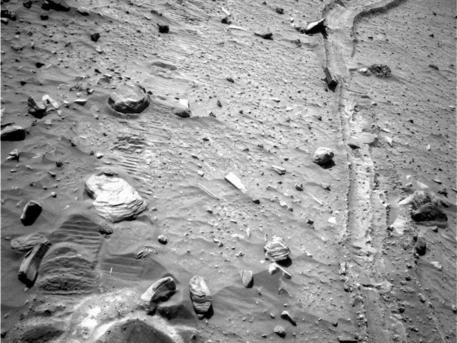Spirit Settles Down
Spirit Stopped, But Not Defeated
 © NASA/JPL-Caltech
|
Spirit's last tracks. This view from Spirit's navigation camera shows tracks left by the rover as it drove backward, dragging its inoperable right-front wheel, to the location where the rover became trapped in soft sand in April 2009.
Ten months ago, as Spirit was driving south beside the western edge of a low plateau called Home Plate, its wheels broke through a crusty surface and churned into soft sand hidden underneath.
After Spirit became embedded, the rover team crafted plans for trying to get the six-wheeled vehicle free using its five functioning wheels – the sixth wheel quit working in 2006, limiting Spirit's mobility. The planning included experiments with a test rover in a sandbox at NASA's Jet Propulsion Laboratory in Pasadena, Calif., plus analysis, modeling and reviews. In November, another wheel quit working, making a difficult situation even worse.
Recent drives have yielded the best results since Spirit became embedded. However, the coming winter mandates a change in strategy. It is mid-autumn at the solar-powered robot's home on Mars. Winter will begin in May. Solar energy is declining and expected to become insufficient to power further driving by mid-February. The rover team plans to use those remaining potential drives for improving the rover's tilt. Spirit currently tilts slightly toward the south. The winter sun stays in the northern sky, so decreasing the southward tilt would boost the amount of sunshine on the rover's solar panels.
"We need to lift the rear of the rover, or the left side of the rover, or both," said Ashley Stroupe, a rover driver at JPL. "Lifting the rear wheels out of their ruts by driving backward and slightly uphill will help. If necessary, we can try to lower the front right of the rover by attempting to drop the right-front wheel into a rut or dig it into a hole."
At its current angle, Spirit probably would not have enough power to keep communicating with Earth through the Martian winter. Even a few degrees of improvement in tilt might make enough difference to enable communication every few days.
Even in a stationary state, Spirit continues scientific research. One stationary experiment Spirit has begun studies tiny wobbles in the rotation of Mars to gain insight about the planet's core. This requires months of radio-tracking the motion of a point on the surface of Mars to calculate long-term motion with an accuracy of a few inches. "If the final scientific feather in Spirit's cap is determining whether the core of Mars is liquid or solid, that would be wonderful - it's so different from the other knowledge we've gained from Spirit," said Squyres.
Tools on Spirit's robotic arm can study variations in the composition of nearby soil, which has been affected by water. Stationary science also includes watching how wind moves soil particles and monitoring the Martian atmosphere.
Spirit may have been stopped, but it hasn't stopped discovering the secrets of Mars.
Source: NASA
Spirit Settles Down
Spirit Stopped, But Not Defeated
 © NASA/JPL-Caltech
|
Spirit's last tracks. This view from Spirit's navigation camera shows tracks left by the rover as it drove backward, dragging its inoperable right-front wheel, to the location where the rover became trapped in soft sand in April 2009.
Ten months ago, as Spirit was driving south beside the western edge of a low plateau called Home Plate, its wheels broke through a crusty surface and churned into soft sand hidden underneath.
After Spirit became embedded, the rover team crafted plans for trying to get the six-wheeled vehicle free using its five functioning wheels – the sixth wheel quit working in 2006, limiting Spirit's mobility. The planning included experiments with a test rover in a sandbox at NASA's Jet Propulsion Laboratory in Pasadena, Calif., plus analysis, modeling and reviews. In November, another wheel quit working, making a difficult situation even worse.
Recent drives have yielded the best results since Spirit became embedded. However, the coming winter mandates a change in strategy. It is mid-autumn at the solar-powered robot's home on Mars. Winter will begin in May. Solar energy is declining and expected to become insufficient to power further driving by mid-February. The rover team plans to use those remaining potential drives for improving the rover's tilt. Spirit currently tilts slightly toward the south. The winter sun stays in the northern sky, so decreasing the southward tilt would boost the amount of sunshine on the rover's solar panels.
"We need to lift the rear of the rover, or the left side of the rover, or both," said Ashley Stroupe, a rover driver at JPL. "Lifting the rear wheels out of their ruts by driving backward and slightly uphill will help. If necessary, we can try to lower the front right of the rover by attempting to drop the right-front wheel into a rut or dig it into a hole."
At its current angle, Spirit probably would not have enough power to keep communicating with Earth through the Martian winter. Even a few degrees of improvement in tilt might make enough difference to enable communication every few days.
Even in a stationary state, Spirit continues scientific research. One stationary experiment Spirit has begun studies tiny wobbles in the rotation of Mars to gain insight about the planet's core. This requires months of radio-tracking the motion of a point on the surface of Mars to calculate long-term motion with an accuracy of a few inches. "If the final scientific feather in Spirit's cap is determining whether the core of Mars is liquid or solid, that would be wonderful - it's so different from the other knowledge we've gained from Spirit," said Squyres.
Tools on Spirit's robotic arm can study variations in the composition of nearby soil, which has been affected by water. Stationary science also includes watching how wind moves soil particles and monitoring the Martian atmosphere.
Spirit may have been stopped, but it hasn't stopped discovering the secrets of Mars.
Source: NASA






